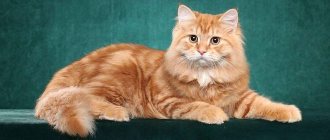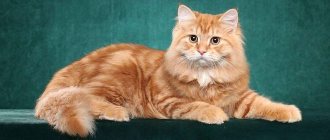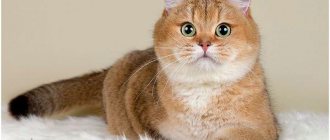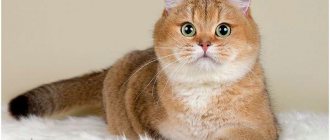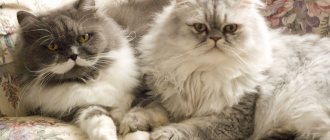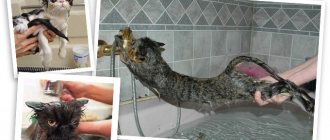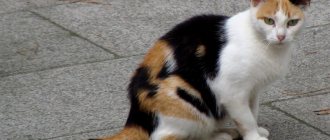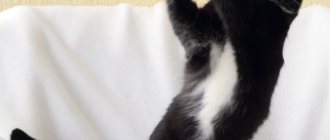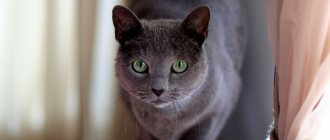Many members of the older generation became acquainted with the chinchilla cat thanks to the James Bond movie saga. The villain Ernst Stavro Blofeld had such a pet. And this was enough for all pet lovers to start talking about the unusual breed of cats. For some time it was believed that we were talking about an as yet unknown elite group. Only later did detailed data about the silver and golden chinchilla color appear.
How did chinchilla cats appear?
England is the homeland of fluffy beauties. It is believed that these cats were born back in 1882 as a result of an accidental crossing of an outbred domestic cat and a Persian cat.
Chinni, as the baby was named, received a non-standard smoky color from her parents, which interested the owner. Subsequently, the breeder crossed Chinny and a gray striped cat, but the result was unsatisfactory: there was no unusual haze in the color of the kittens’ fur.
A few years later, the descendants acquired the desired chinchilla color, and appeared at London exhibitions at the Crystal Palace in 1894. The apricot color appeared much later among American breeders.
For about 30 years, the breed was small in number, despite the efforts of breeders. The 30s of the 20th century changed the situation, and the population increased significantly, thanks to which the first breed standard appeared in 1952.
Where to buy a kitten?
British chinchillas are considered quite rare, and therefore cannot be purchased from a dubious breeder that you found in an ad or in the first nursery you come across.
As a rule, silver and golden chinchillas are bred only in specialized nurseries that have the appropriate license. Such nurseries are mainly monobreeds; other kittens are not bred in them. Moreover, it is worth understanding that such kittens cannot cost several thousand rubles. The average price for a British chinchilla with documents and pedigree (for sterilization or castration) varies from 20 to 40 thousand rubles. Animals for breeding cost many times more.
The price of a kitten may also depend on its color, possible defects on it, eye color and some other factors. Kittens whose parents are champions and have corresponding titles are even more expensive.
For more information about the British chinchilla breed, see the following video.
Appearance of chinchillas
Outwardly, they are similar to their “relatives” of Persian cats, which are characterized by white fur with small dark patches, thanks to which a shimmer of silvery shine is visible. Emerald green eyes edged with black. The chinchilla was the first breed whose color was obtained through deliberate selective breeding. It was first presented in 1894 at the World Exhibition at the Crystal Palace in London.
There are several groups of characteristic colors for chinchillas. The first group includes dark shades: chocolate, cinnamon, silver tint. The second includes, based on the red tone: red and cream chinchilla cat. The third category includes tortoiseshell colors: silver and chocolate tortoiseshell. And in the last one - these are diluted tortoiseshells: lilac-cream, fawn and cream with a blue tint.
Genetics of color
A polygenic complex is responsible for the golden chinchilla color, providing a warm shade of the undercoat and a lightened background color:
- melanin inhibitor – absorbs hair pigment, starting from the hair root;
- agouti and tabby (tabby) - forms a pattern;
- erizer – gene eraser, gives the undercoat a warm shade.
The golden chinchilla color includes several varieties depending on the color of the hair tips:
- black;
- chocolate;
- lilac;
- faun (fawn);
- cinnamon (cinnamon);
- blue.
The golden color is a recessive trait in relation to the silver color. Kittens of this color can be obtained in the following cases:
- both manufacturers have a golden color;
- parents are silver chinchillas, but are carriers of the golden gene;
- one producer is golden, the second is silver, but his genotype contains genes for goldenness.
Breed standards
It identifies characteristics inherent in animals. The standard maintains the purity of the breed and is a document that allows participation in breeding and exhibitions.
It is used by breeders, judges and breeders. One might say that this is the “basic law” of felinology. In essence, this is a description of the breed in strict order. Standard for Chinchilla Persians:
- rounded and soft lines of a small head with a convex skull and a squat, compact body.
- Males in adulthood reach a weight of 7 kg, and females 3.5-4.5 kg.
- Widely spaced ears with rounded ends.
- Bright, wide-set, large eyes with black rims.
- Pale pink or brick red short nose.
- Short stocky paws with dark pads.
- Short straight tail.
Thick long hair. Kittens of this breed are born with short hair, but over time it becomes longer.
Origin
The breed was bred in Great Britain when, in the 70s of the last century, English breeders decided to cross Persian and British Shorthair cats. The idea was crowned with success - the result of the work done was unusually beautiful animals with luxurious fur and a squat, powerful physique. Soon all the necessary documentation describing the characteristics of the breed was fully approved. In 1980, the first official representative of the British chinchilla named Silver Lambkin was presented to the public, who later became the champion of many international exhibitions.
Character of chinchilla cats
They have a soft and friendly character. Thanks to their high intelligence, chinchilla cats get along well in an apartment; with proper training, they use a scratching post, so furniture and walls will not be damaged by sharp claws.
They carefully examine the home and every corner without causing problems to the owner. Representatives of this breed are a little phlegmatic, so pranks are not inherent in them.
Chinchillas are great companions for people who live alone because cats do not become overly sad when their owner is away.
Cats get along quite well with other animals and are friendly, but this breed is not among the best for contact with children, although each pet is individual. The best option is when both animals live together since childhood, then there will be no aggressive relationship between them. If different ages or genders are combined, conflicts may arise.
Predisposition to diseases
The British Shorthair has a long history, and one of the results of meticulous selection is that these animals have excellent health and excellent disposition. This is a long-lived breed. However, due to crossbreeding with Persian cats, some members of the chinchilla variety sometimes have kidney disease, although this is not common.
Polycystic kidney disease and blood type B
In the 20th century, British Shorthair breeders used Persian cats to create a chinchilla line.
Persians are prone to an inherited kidney disease called polycystic kidney disease. Since then, outbreaks of this disease have been periodically reported in the UK. A more common problem for British cats is the rare blood type that some of these cats have. British Shorthairs can be Type A or Type B. Most have Type A blood. Some have Type B. It is not a blood disorder, and Type B cats are just as healthy as Type A cats. But for breeding purposes or if blood transfusions are needed this must be taken into account. Type A blood will kill a cat with type B blood and vice versa. British shorthair breeders are worried about blood type due to "fading kitten" syndrome. When the mother cat has type B blood and the father of the kittens has type A blood, their kittens can have both type A and type B blood. Mother's milk contains antibodies to type A, which will kill type A kittens within 72 hours. Fortunately, there is now a DNA test to check the blood type before breeding a cat.
Diseases inherent in chinchillas
Despite good health, during breeding and selection of certain traits, diseases at the genetic level were practically not established in the breed, this is due to the fact that breeders mixed different breeds of cats and less often resorted to inbreeding, i.e. breeding a breed by crossing close relatives to consolidate signs.
Due to the anatomical features of the skull, Persian chinchillas have increased tear production. To prevent possible eye problems, you need daily eye care. To do this, you need a napkin moistened with water. We take it and wipe the eyes and the area around them until the wool is clean. Then treat the area with grooming paste and comb it with a special brush, which can be bought at a pet store. The final stage is sprinkling with special powder.
Chinchillas are classified as Persians, and since they are a genus of long-haired cats. Accordingly, they have typical problems for owners of long hair.
When washing, the cat's rough tongue collects excess hair and swallows it. This is fraught with regurgitation of lumps and diseases of the digestive system and gastrointestinal tract. For this reason, they need regular combing of dead hairs.
Due to the small head and flat muzzle, the jaw may become deformed. Eating may be difficult if the food and water bowls are not suitable, for example, they are too small for the head to fit through. Due to the distortion of the airways, chinchillas may experience breathing problems.
At the genetic level, some cats have a gene that causes kidney failure. In the 1990s, a study found that more than 30% of shorthaired Persians had polycystic kidney disease, but it was less common in chinchilla cats.
About castration
A sensitive topic among cat lovers: sterilization should not be regretted. Each owner decides for himself, but what do experts think about this? Opponents rely on myths that it is “good for health” and has a beneficial effect on the animal’s psyche.
In fact, there is no concept of “sexual dissatisfaction” for a pet. If behavior changes for the worse, then the problem may be hormonal changes or hidden diseases. An examination by a veterinarian will answer this question.
For example, unsterilized cats that have not become pregnant may develop cystic degeneration of the ovaries and uterus, and mastopathy. Prostate lesions are common in cats. Veterinary clinics are unanimous: if the animal is not involved in breeding, castrate it.
About vaccinations
The mother cat transmits immune bodies through milk that support the protection of babies from diseases, so vaccinations are given no earlier than two months of age. Vaccination is carried out according to age according to the preventive calendar:
- Upon reaching 8 weeks, they are vaccinated against panleukopenia, rhinotracheitis, chlamydia, microsporia and calcivirosis.
- The next stage is 10-12 weeks. At this time, a repeat vaccine is administered, plus one against rabies.
- At 16 weeks - viral peritonitis, and again after 4 weeks.
- The final stage is revaccination every year.
The procedure can be carried out safely by a doctor only for healthy animals after a preliminary examination.
Castration and sterilization
If you do not intend to breed offspring, then you should think about castration and sterilization of your pet.
Castration is the complete removal of the gonads of representatives of both sexes: removal of the testes in males and ovaries in females through surgery.
Sterilization is a more gentle procedure in which the veterinarian ties the vas deferens in cats and the fallopian tubes in females. This procedure will not discourage sexual desire in pets, but they will not be able to reproduce.
At what age is it recommended to do it?
Many experts say that the sooner this operation is performed, the better. Others believe that it is harmful for the pet, preferably later, at the age of 2-3 years.
The optimal age for the procedure is considered to be from six months to a year. At this age, the influence of sex hormones is not yet too strong, and the genitals are already sufficiently formed for surgical intervention.
Caring for your pet after surgery
For the first 6–12 hours after surgery, feeding your pet is strictly prohibited to avoid the gag reflex. You can only give water. After returning home, the pet should be placed on a towel in a comfortable, warm place, protected from drafts. You should not place your pet on elevated surfaces, as after anesthesia he will be disoriented and may fall. Cats wear a special bandage to protect the sutures for several days after surgery.
Postoperative blankets protect the cat's stitches
If the animal is very scared, you should calm it down, stroke it, and hold it.
How to choose a cat?
There are several rules that can protect you from unscrupulous scammers. It should be remembered that this breed is not common in the CIS, there are few qualified nurseries, so the average price tag is quite high.
For this reason, do not buy kittens from the market. An animal can only look like a chinchilla, but not be one. In addition, responsible breeders sell offspring through clubs and subsequently monitor their fate. This does not mean that the cat will be bad; while maintaining the demand for such kittens, sellers will continue to be interested in unscrupulous business.
Kittens are very curious, so a healthy pet will be interested in meeting the future owner. If he is shy, aggressive or looks lethargic, then this indicates poor living conditions.
If you want to know how a kitten will grow up, then look at its parents. If the mother cat is near the children, then the father can be seen in copies of his documents or photographs.
Psychology
The magnificent Persian chinchilla cat is a bright and central representative of the breed.
- She is characterized by a playful disposition and curiosity. She is perfect for owners with the same restless behavior.
- If your pet is not supported in his fun, he will quickly become lazy and lethargic, which will have a bad effect on his physical condition - this often happens with Scottish Straight cats and Scottish Fold cats .
- Chinchillas have a special relationship with children; they do not shy away from them, but they will not mindlessly give in to children’s whims.
- The animal will not be able to make friends with another cat in the house. Silver lambkins do not tolerate superiority and will quickly put their opponent in their place.
British chinchilla cat
The delicate British chinchilla cat is very different in its behavior from the traditional British cat.
She has hypertrophied aristocracy and a very gentle character.
- Affectionate and calm, they have high intelligence and quick wits.
- They love to talk, using only two words: “purr” and “meow,” but playing with intonations in such a way that it seems like a completely reasonable dialogue between the owner and the animal.
If you are interested in learning how cats purr, we recommend reading the article
- British chinchillas are mannered and do not tolerate unceremonious interference in their personal space. You can pet your pet, but he will not allow you to squeeze or pinch.
- Cats intuitively understand their importance and behave accordingly. If they lie down, then imposingly, if they walk, then with the highest dignity.
Two breeds, one color, what are the differences?
When choosing a kitten, remember that the chinchilla cat breed is a whole world built on the external beauty of the animal.
Buying a chinchilla kitten is difficult, if not very problematic. The main difficulty is that the magnificent color of the animal is pathologically unstable
How to care for a chinchilla cat?
Caring for pets begins even before they are born. Proper nutrition of the expectant mother is the key to healthy offspring. A balanced diet consists of raw meat products and offal, as well as fermented milk in small quantities. Vegetables and fruits are added to balance microelements. For proper intrauterine development of kittens, the mother does not set up a den in a quiet place.
Vaccinations
Good health is an integral part of a long and happy pet's life. To maintain it, the animal must be vaccinated.
Vaccination begins at an early age. The first vaccinations are given at the age of one and a half to two months. Injections are given against rabies, rhinotracheitis, feline distemper and calcivirosis. Then, after two and a half to three months, revaccination occurs. Then vaccinations are given annually, once a year. The selection of a quality drug should be entrusted to a veterinarian.
Ten days before vaccination, the animal must be dewormed.
From the first days of life
Complementary feeding and litter box training begin when kittens reach 4-5 weeks of age. When raising one, it should be taken into account that a cat is not a person; it is not characterized by associative thinking and understanding of human behavior. If you set a ban for her, then it is forever.
Toilet training is taught from the first steps, for this:
- fence off the space for 2-3 weeks;
- put two small trays;
- fill with filler with small granules.
This is necessary so that the kitten remembers its smell and subsequently goes to only one place. If the baby has done “big” things bypassed, then put it in the litter with a scoop and do not remove it.
Long-lived domestic cats
The record holder for life expectancy is a cat named Lucy, who lives in the UK. According to official data, she is 43 years old. Translating to our human age, it turns out that the cat is almost 175 years old. In second place is the cute cat Cream Puff, originally from the USA, who lived a happy life at the age of 38, leaving this world in 2005.
Well, in third place among long-livers among mustachioed fluffy pets is a cat who once lived in Devon (England). He lived happily until his 36th birthday, after which he calmly passed away. By the way, the mentioned animals are Guinness Book record holders in the section of long-livers among domestic cats.
Adult pets
For pet chinchillas that do not participate in exhibitions, care will not be difficult. The owner of the “Show Dream” nursery in an interview shared advice on caring for a cat’s fur: once a month, using specialized shampoos, you need to bathe an adult cat, and kittens twice, and after the bath, dry it with a hairdryer to completely remove fallen hairs. She also explained that it is advisable to comb the cat once every 1.5-2 weeks to prevent the formation of tangles.
Nutrition can be provided in two ways: make a diet from fresh food or buy premium or super-premium food, for example, Brit, Brit care. When it comes to dry food, holistic foods, such as Acana, are considered the best. There are separate lines for pets with urolithiasis.
If one food suits the animal, the stool is in good condition, the eyes are shiny and the coat is in good condition, then there is no need to mix different tastes, it is enough to feed one type.
Feeding the animals
For feeding golden chinchillas, like other purebred cats, high-quality ready-made food with a protein content of at least 30-35% is suitable. They have a balanced composition and fully satisfy the needs of the animal’s body.
The following brands have proven themselves well:
- 1st Choice;
- Hills;
- Acana;
- Leonardo;
- Sanabelle Bosch;
- Pro Plan.
If the owner chooses a natural diet, then it is based on meat - turkey, chicken, veal. The meat needs to be frozen for 2-3 days. It is given raw, cut into pieces and doused with boiling water. These measures are necessary to destroy parasites and bacteria.
Cats do not refuse offal. Liver, lung, heart, tripe are suitable for feeding. They must be boiled for several hours.
Also included in the diet:
- rice and buckwheat porridges;
- boiled sea fish fillet (if you have problems with the genitourinary system, this product is excluded);
- boiled vegetables (zucchini, carrots, pumpkin, cauliflower);
- egg yolk (no more than 2 times a week);
- fermented milk products with low fat content (kefir, yogurt, cottage cheese, natural yogurt).
Pets are fed 2-3 times a day. Food from the human table is contraindicated for animals.
Important. The structure and appearance of the coat directly depend on the quality of nutrition. Errors in feeding lead to dull and brittle fur and prolonged molting.

